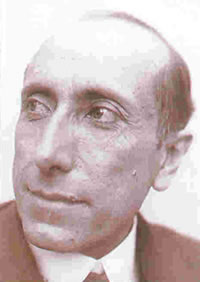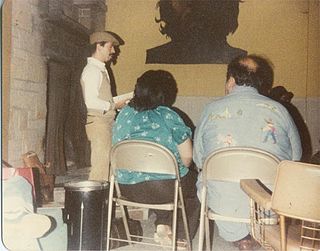
Chicano or Chicana is an identity for Mexican Americans who have a non-Anglo self-image. Chicano was originally a classist and racist slur used toward low-income Mexicans that was reclaimed in the 1940s among youth who belonged to the Pachuco and Pachuca subculture. In the 1960s, Chicano was widely reclaimed in the building of a movement toward political empowerment, ethnic solidarity, and pride in being of indigenous descent. Chicano developed its own meaning separate from Mexican American identity. Youth in barrios rejected cultural assimilation into whiteness and embraced their own identity and worldview as a form of empowerment and resistance. The community forged an independent political and cultural movement, sometimes working alongside the Black power movement.

Amado Nervo also known as Juan Crisóstomo Ruiz de Nervo, was a Mexican poet, journalist and educator. He also acted as Mexican Ambassador to Argentina and Uruguay. His poetry was known for its use of metaphor and reference to mysticism, presenting both love and religion, as well as Christianity and Hinduism. Nervo is noted as one of the most important Mexican poets of the 19th century.

The Plan Espiritual de Aztlán was a pro-indigenist manifesto advocating Chicano nationalism and self-determination for Mexican Americans. It was adopted by the First National Chicano Liberation Youth Conference, a March 1969 convention hosted by Rodolfo Gonzales's Crusade for Justice in Denver, Colorado.

José Vasconcelos Calderón, called the "cultural caudillo" of the Mexican Revolution, was an important Mexican writer, philosopher, and politician. He is one of the most influential and controversial personalities in the development of modern Mexico. His philosophy of the "cosmic race" affected all aspects of Mexican sociocultural, political, and economic policies.

Alcides Arguedas Díaz was a Bolivian writer and historian. His literary work, which had a profound influence on the Bolivian social thought in the first half of the twentieth century, addresses issues related to national identity, miscegenation, and indigenous affairs. His most significant work, Raza de bronce (1919), is considered one of the most influential Bolivian literary works and a precursor of indigenism.

The Greater Mexico, Reconquista ("reconquest") is a term to describe an irredentist vision by different individuals, groups, and/or nations that the Southwestern United States should be politically or culturally returned to Mexico. Such opinions are often formed on the basis that those territories were claimed by Spain for centuries and then by Mexico from 1821 until they were ceded to the United States during the Texas Annexation (1845) and the Mexican Cession (1848) because of the Mexican–American War.

La raza cósmica is a Spanish-language book written and published in 1925 by Mexican philosopher, secretary of education, and 1929 presidential candidate José Vasconcelos to express the ideology of a future "fifth race" in the Americas; an agglomeration of all the races in the world with no respect to color or number to erect a new civilization: Universópolis.

Rodolfo "Corky" Gonzales was a Mexican-American boxer, poet, political organizer, and activist. He was one of many leaders for the Crusade for Justice in Denver, Colorado. The Crusade for Justice was an urban rights and Chicano cultural urban movement during the 1960s focusing on social, political, and economic justice for Chicanos. Gonzales convened the first-ever Chicano Youth Liberation Conference in 1968, which was poorly attended due to timing and weather conditions. He tried again in March 1969, and established what is commonly known as the First Chicano Youth Liberation Conference. This conference was attended by many future Chicano activists and artists. It also birthed the Plan Espiritual de Aztlán, a pro-indigenist manifesto advocating revolutionary Chicano nationalism and self-determination for all Chicanos. Through the Crusade for Justice, Gonzales organized the Mexican American people of Denver to fight for their cultural, political, and economic rights, leaving his mark on history. He was honored with a Google Doodle in continued celebration of National Hispanic Heritage Month in the United States on 30 September 2021.

Chicanismo emerged as the cultural consciousness behind the Chicano Movement. The central aspect of Chicanismo is the identification of Chicanos with their Indigenous American roots to create an affinity with the notion that they are native to the land rather than immigrants. Chicanismo brought a new sense of nationalism for Chicanos that extended the notion of family to all Chicano people. Barrios, or working-class neighborhoods, became the cultural hubs for the people. It created a symbolic connection to the ancestral ties of Mesoamerica and the Nahuatl language through the situating of Aztlán, the ancestral home of the Aztecs, in the southwestern United States. Chicanismo also rejected Americanization and assimilation as a form of cultural destruction of the Chicano people, fostering notions of Brown Pride. Xicanisma has been referred to as an extension of Chicanismo.

The Spanish expression la Raza has historically been used to refer to the Hispanophone populations, considered as an ethnic or racial unit historically deriving from the Spanish Empire, and the process of racial intermixing of the Spanish colonizers with the indigenous populations of the Americas.

Alberto Baltazar Urista Heredia, better known by his nom de plume Alurista, is an American poet and activist. His work was influential in the Chicano Movement and is important to the field of Chicano poetry.
Chicano nationalism is the pro-indigenist ethnic nationalist ideology of Chicanos. While there were nationalistic aspects of the Chicano Movement of the 1960s and 1970s, the movement tended to emphasize civil rights and political and social inclusion rather than nationalism.
La Raza are the people of the Hispanic and Chicano world.

There is no single system of races or ethnicities that covers all modern Latin America, and usage of labels may vary substantially.

Chicana literature is a form of literature that has emerged from the Chicana Feminist movement. It aims to redefine Chicana archetypes in an effort to provide positive models for Chicanas. Chicana writers redefine their relationships with what Gloria Anzaldúa has called "Las Tres Madres" of Mexican culture by depicting them as feminist sources of strength and compassion.
Fernando Chaves Reyes was a novelist, essayist, and journalist. He was the first Ecuadorian writer to depict an indigenous theme in his writings.

Xicanx is an English-language gender-neutral neologism and identity referring to people of Mexican descent in the United States. The ⟨-x⟩ suffix replaces the ⟨-o/-a⟩ ending of Chicano and Chicana that are typical of grammatical gender in Spanish. The term references a connection to Indigeneity, decolonial consciousness, inclusion of genders outside the Western gender binary imposed through colonialism, and transnationality. In contrast, most Latinos tend to define themselves in nationalist terms, such as by a Latin American country of origin.

A Mexican American is a resident of the United States who is of Mexican descent. Mexican American-related topics include the following:

The Monumento a la Raza is a 50 meters (160 ft) high pyramid in northern Mexico City. It is located in the intersection of Avenida de los Insurgentes, Circuito Interior and Calzada Vallejo, in the Cuauhtémoc borough.
Raza de Bronce is a 1919 novel by the Bolivian writer Alcides Arguedas. It is considered one of the most important novels in Bolivian literature, and has been recognized as such by a number of critical studies as well as by the Bolivian government. The novel was published by Prometeo; a French translation appeared in 1919 but as of 2023, no English translation exists.












